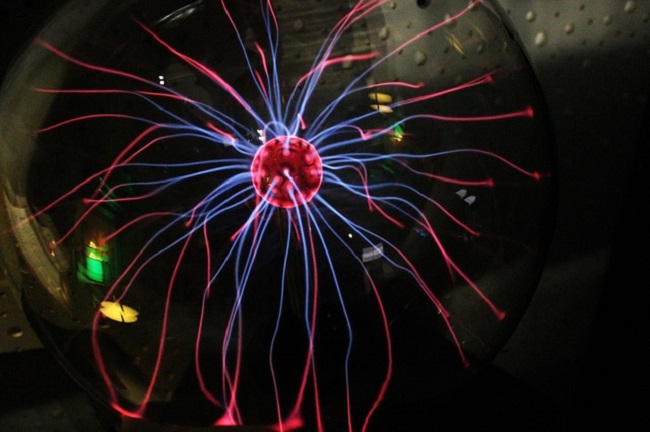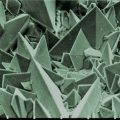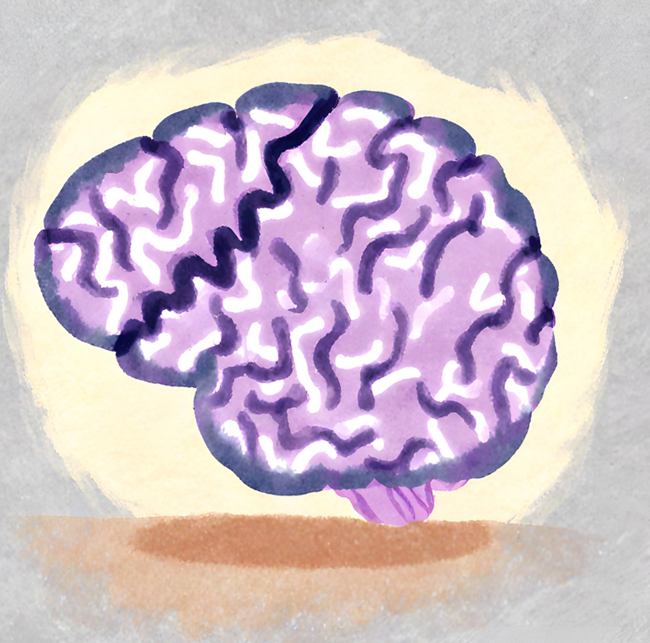Electromagnetic hypersensitivity syndrome (EHS) has gained increasing attention over the last few years. The syndrome is marked by a variety of non-specific symptoms following both acute or chronic exposure to electromagnetic fields. EHS symptoms manifest broadly across multiple organs, but are especially troubling when affecting the central nervous system. Over the last year and after reading Thiamine Deficiency Disease, Dysautonomia and High Calorie Malnutrition, I have become increasingly convinced of the need for thiamine in chronic illness. Many of my patients have experienced great benefit with thiamine supplementation, including those with EHS. About month ago, I dug into the research and uncovered the connections between EHS, mitochondrial fitness and thiamine. I published the following post on my website (here). This is a republication, edited for Hormones Matter.
Electromagnetic Hypersensitivity Syndrome
For those who are not aware, electromagnetic hypersensitivity syndrome is characterized by collection of symptoms which manifest when someone comes in close contact with non-native electromagnetic frequencies. Non-native refers to the unnatural, man-made electromagnetic fields (EMF) emitted from electronic devices, mobile phones, WiFi, dirty electricity (high-voltage power surges in standard wiring with limited capacity), and overhead power lines.
The symptoms of EHS are wide and varied in number, but they typically include brain fogginess, insomnia, skin rashes, palpitations, anxiety, depression, physical sensations of pain, headaches and migraines, neuropathies and paresthesias, and burning sensations in the limbs. Unfortunately, many patients with this condition are dismissed by their physicians, who consider the origin of these symptoms to be purely “psychosomatic”.
In my experience, I have found that people who are sensitive to EMF sometimes respond very well to specific nutrient supplementation. One nutrient in particular, a derivative of vitamin B1/thiamine called thiamine tetrahydrofurfuryl disulfide – TTFD, appears to work best. After witnessing many clients achieve great improvements with this nutrient, I sought to understand why this could occur on a mechanistic level. This article aims to explain why thiamine TTFD works very well for some people with EHS.
Is EMF-Sensitivity/EHS A Real Condition?
Despite conventional medical claims that EHS is primarily “psychosomatic”, there have been several researchers who have demonstrated real, physiological changes occurring in EHS. These changes are indicative of increased levels of oxidative stress like those found in multiple chemical sensitivity syndrome. Patients with EHS were found to have increased blood concentrations of malondialdehyde (a lipid peroxide), oxidized glutathione, and nitrotyrosine. Beneficial glutathione-associated biomarkers were lower in 20-40%, and red blood cell (RBC) superoxide dismutase and glutathione peroxidase activity were increased in 60% and 19%, respectively. Overall, this trial showed that 80% of EHS sufferers presented with one, two, or three elevated biomarkers of oxidative stress.
In another study, EHS patients were shown to have higher levels of oxidized antioxidants vitamin E and coenzyme Q10. RBC glutathione-S-transferase was decreased, along with reduced glutathione levels. These findings indicate an increased demand for antioxidants which cannot be met, and are consistent with a state of oxidative stress.
Furthermore, genetic analysis identified two genotypes related to glutathione status [GSTM1 (*0/*0) + GSTT1 (*0/*0)] which were more common in EHS sufferers compared with controls. The enzyme encoded by these two genes is called glutathione-S-transferase, and this is facilitates the conjugation of glutathione with toxins and waste-products to carried out of the cell and detoxified. Genetic polymorphisms in these genes can reduce the activity of this enzyme, which might impair an individual’s ability to protect against to oxidative stress. This specific genotype combination conferred a 9.7 times higher risk of developing EHS, which suggests that some people may be more genetically susceptible to developing this condition than others.
EHS patients were matched with controls in a study measuring cortical excitability parameters using transcranial magnetic stimulation. Those with EHS were found to display significant differences in cognitive and neurobiological activity, demonstrating genuine changes in brain function which occur in this condition. One individual with self-diagnosed EHS was shown to have abnormalities on functional MRI scanning which looked similar to traumatic head injury. Whilst another double-blinded case study demonstrated clear somatic responses to EMF exposure which included muscle twitching, arrhythmia, headache and temporal pain.
Some researchers have proposed that EMF-sensitivity may be related to heavy-metal toxicity and exposure. Although one study showed no differences in blood metal concentrations in EHS, it is well established that blood levels are not always reflective of tissue metal concentrations. A case study in Japan correlated dental titanium implants with EHS-related symptoms such as vertigo and dizziness. These symptoms disappeared after the metal implants were removed, leading the researchers to theorize that the titanium was acting as some form of “antennae” for EMF radiation.
In addition, the EMF emitted from mobile devices has the capacity to increase the release of mercury vapor from amalgam fillings into saliva. The same effect can also occur through exposure to magnetic resonance imaging (MRI) scanning. Since mercury is a highly neurotoxic substance, it is believed that heavy metal poisoning may be responsible for producing or exacerbating the symptoms associated with EHS.
Based on the above data, coupled with innumerable anecdotes, it would indeed appear that EHS is a genuine physiological condition. This condition appears to feature alterations in brain function, clear differences in biomarkers associated with increased oxidative stress, and somatic responses upon exposure to EMF devices.
However, this does not mean that EHS sufferers are the only ones who are negatively impacted by exposure to nn-EMF. In fact, there is a vast body of literature demonstrating substantial damage done to cellular systems upon exposure to this radiation. To go through all of the evidence would be frankly impossible, and even a comprehensive overview is way beyond the scope of this article. Nevertheless, in order to understand why the addition of specific nutrients may be beneficial in protecting the brain from the negative consequences of EMF exposure, we need to examine some of the processes that occur at the molecular level with irradiation.
EMF and the Brain
The exact mechanisms by which different frequencies of EMF interact with different cell types have not yet been fully characterised. It is thought to involve voltage-gated calcium channel activation and calcium efflux, resulting in elevated nitric oxide synthesis, peroxynitrite free radicals, neuro-inflammatory cascades and glutamate-neuro excitotoxicity. What is clear, however, is that mitochondrial dysfunction and oxidative stress are the main drivers behind EMF-induced brain injury.
The high rate of oxygen consumption and metabolism of the brain, coupled with its high neuronal membrane content of unsaturated fatty acids, make it uniquely susceptible to oxidative damage. This, paired with the fact that mobile devices are generally positioned in close proximity to the face and head, render the brain a prime target for electromagnetic radiation.
Neuro-excitotoxicity is a phenomenon characterised by excessive release of the excitatory neurotransmitter glutamate and subsequent activation of NMDA receptor and AMPA receptors. The persistent and extreme stimulation of neuronal activity yields high levels of reactive oxygen species (ROS), and eventually leads to cell degeneration and death. Excitotoxicity is considered to be one of the main underlying drivers behind neurodegeneration, brain injury, and age-related cognitive decline.
EMF in the extreme low frequency range at a power intensity present in some occupational exposures can indeed influence glutamate concentrations at the neuronal synapse, producing 40% higher or 35% lower concentrations depending on the frequency, intensity, and duration of exposure. A variety of proteins involved in the glutamate receptor signalling pathway in the hippocampus were also significantly elevated after prolonged exposure to radio-frequency EMFs (900-2100MHz) which is similar to what is emitted from GSM mobile devices.
RF-EMF exposure also enhanced glutamate-induced cytotoxicity and cell death in mouse hippocampal HT22 cells, and the introduction of an antioxidant (NAC) provided complete protection against this. Together, these results suggest that excess glutamate may indeed play a key role in EMF-induced brain damage, and this is an important point to remember. However, there are also other neurotransmitters which are affected through EMF exposure, albeit in different ways.
Another study showed significant disturbances in norepinephrine (noradrenaline), dopamine, and 5-hydroxytryptophan, with the authors concluding that these changes “may underlie many of the adverse effects reported after EMR including memory, learning, and stress.”
Alterations in N-methyl-d-aspartate (NMDA) and gamma aminobutyric acid type A (GABAA) receptors, along with dopamine transporters, were also found in rat brains exposed to 15 minutes of 900-MHz radiation emitted from a GSM mobile phone device. That same study identified a strong glial reaction in the striatium region of the brain, potentially suggestive of neuronal damage.
A separate experiment showed that other areas of the brain including the cortex, hippocampus, and basal ganglia exhibited significant neuronal damage after rats were exposed to a GSM device for just 2 hours. Numerous other studies have demonstrated neurobehavioral impairments, increase blood-brain barrier permeability, brain structure alterations and cognitive deficits.
To make matters worse, 5 hours per day of exposure to a frequency similar to that emitted from 4G mobile phones (835 MHz) caused great damage to the myelin sheath which resulted in demyelination. For reference, myelin is the protective fatty coating that lines neurons, and is essentially responsible for facilitating the passage of signals from one neuron to the next. Without myelin, nerve signals cease and the nervous system as a whole is unable to effectively coordinate activity. Progressive demyelination has been identified in several neurodegenerative conditions, one of which is Multiple Sclerosis.
EMF and Mitochondrial Function
As I highlighted previously, the common offender in EMF-related tissue and cellular damage is disturbed redox balance and oxidative stress. The body’s main defence against this is the endogenous antioxidant system, which is tasked with protecting cells from the destructive effects of reactive oxygen species (ROS). When this innate system is unable to effectively manage oxidative injury, this is referred to as “oxidative stress”. Reduced antioxidant capacity in the context of elevated ROS can quite easily lead to nerve cell death and tissue destruction, so it is crucially important to maintain a healthy balance between oxidants and reducing agents.
Mitochondria, as the main metabolic hub responsible for energy synthesis in the cells, are known to be the main source of intracellular ROS. ROS generation occurs as a normal byproduct of energy metabolism and plays a variety of important signalling roles, but can increase to pathological levels when mitochondria are stressed, damaged and dysfunctional. And like I said before, one of the primary mechanisms behind EMF-induced damage is linked to mitochondrial dysfunction.
Mitochondria appear to be quite susceptible to injury from EMFs. Long-term, low dose cumulative MW-EMF exposure leads to structural damage, which includes swelling, cavitation, and broken cristae of mitochondria in the hippocampus and cortex.
Significant reductions in ATP synthesis by hippocampal mitochondria were found in rats exposed to pulsed MW, whilst succinate dehydrogenase, a key enzyme in energy metabolism, also demonstrated much lower activity. Another mitochondrial enzyme called Cytochrome C oxidase (COX) is also affected. COX sits at the last step of ATP synthesis, where it is tasked with transferring electrons to oxygen to produce H2O and ATP. After irradiation with MW-EMF, COX enzyme activity, COX mRNA, and COX I protein were significantly reduced.
The exact mechanisms by which EMFs destroy mitochondrial integrity are not yet fully not understood, although it seems to include the following:
- EMF can lead to abnormal expression of genes encoding proteins in the respiratory chain, producing errors in energy metabolism.
- EMF can damage the mitochondrial membrane through altering molecular rotation, vibration, and collision frequency to produce changes in membrane structure.
- The activation of NADH oxidase by EMF mediates an increase in ROS, which likely targets the mitochondrial membrane, disrupts mitochondrial efficiency, and overwhelms the cell. Dysfunctional mitochondria then go on to produce more ROS in a vicious cycle. ROS may also damage mitochondrial and nuclear DNA, create DNA strand breakages and mutations, and reduce energy synthesis capacity.
- Calcium efflux or “overload” can occur, where high concentrations of calcium ions flood into the cell through voltage gated calcium channels. This can activate the mitochondrial permeability transition pore, resulting in swelling, fragmentation, and even cell death.
The resulting consequence is that cells lose the ability to make energy in an efficient or “clean” way. Mitochondria begin to spew out excessive ROS. Likewise, the ROS generated via other sources can quite easily overwhelm our endogenous protective systems to produce a catastrophic state of oxidative stress.
Additional Mechanisms of Mitochondrial Damage
Pineal release of melatonin, the brain’s primary antioxidant and radical scavenger, is substantially reduced under exposure to specific frequencies of radiation. Unfortunately, low melatonin is a key risk factor for the development of neurological dysfunction, neurodegeneration, and other pathologies including cancer of various kinds. Furthermore, key intracellular antioxidants including glutathione, catalase, and superoxide dismutase are also deteriorated through ELF-EMF exposure at 60Hz.
EMF emitted by mobile devices was found to deplete key glutathione biomarkers including glutathione (GSH) itself and glutathione peroxidase, glutathione reductase and glutathione s-transferase in rat brains. Malondialdehyde, a marker of lipid peroxidation, was also greatly elevated.
A different study on guinea pig brain tissue also showed a reduction in GSH, catalase, and elevations in malondialdehyde. Together, these biochemical parameters are consistent with a state of excessive oxidative stress in the brain cells.
It is important to note that there are many other studies demonstrating effects consistent with this. Namely, that chronic EMF exposure takes a massive toll on the endogenous antioxidants.
To summarise so far:
- EHS/EMF-Sensitivity is a genuine physiological condition characterised by altered biomarkers associated with oxidative stress.
- EMF exposure alters levels of neurotransmitters including dopamine, norepinephrine, and glutamate. Excess glutamate may produce excitotoxicity, which can lead to cell death.
- EMF exposure produces damage to neurons and brain tissue via increased generation of ROS.
- EMF exposures can damage mitochondria in several ways to cause mitochondrial dysfunction, which further enhances ROS production and reduces ATP.
- The oxidative burden associated with chronic EMF is associated with reduced levels of antioxidants including melatonin, glutathione, and other antioxidant enzymes.
With the above in mind, it is clear that there are genuine dangers posed by exposures to these electronic devices and other sources of electromagnetic radiation. Whilst I believe that the best protection against this is strict avoidance, it is frankly not possible in our modern world. As a result, sleep and circadian hygiene, intelligent movement, stress-management and a nutrient-dense diet become critical. However, these changes are not always successful and so the next best solution would be to devise strategies to aid our cells’ ability to mitigate some of the damage by supporting mitochondrial health and reducing the oxidative burden. As we will examine next, thiamine possesses many of the characteristics, which make it a useful candidate for supporting neurological health and protecting cells against some of the detrimental effects exerted by EMFs.
EMF and the Thiamine Connection
First, I should make clear that no studies, to my knowledge, have been done on the direct actions of thiamine in relation to EMF. However, my clinical experience with people who have EHS coupled with the mechanistic data justifies the use of this nutrient in my opinion. The benefits of thiamine for the brain and neurological system are well-established, and thiamine deficiency is known to manifest primarily as neurological dysfunction.
The mitochondrial dysfunction and oxidative stress induced by EMF no doubt increases thiamine requirements. On the other hand, an oxidative environment is also thoroughly detrimental to thiamine homeostasis. Not only does oxidation increase the need for thiamine in the brain, but oxidative stress also disturbs thiamine homeostasis and negatively influences the enzymes that use thiamine as a cofactor.
Protecting cells from the destructive consequences of excessive oxidation requires a continual supply of energy. The active form of thiamine, thiamine pyrophosphate (TPP) plays a critical cofactor role for multiple enzymes required for the generation of this energy in the form of ATP. The pyruvate dehydrogenase complex (PDHC), sitting at the entry point to oxidative metabolism of glucose, requires thiamine as a cofactor. The rate of glucose metabolism has been shown to rapidly increase in response to EMF in brain regions closest the antennae. Alone, this naturally increases thiamine turnover.
Alpha-ketoglutarate dehydrogenase (KGDH) is another thiamine-dependent mitochondrial enzyme complex involved in the TCA cycle. Of all of the enzymes involved in energy metabolism, KGDH is one of the most sensitive to oxidative stress.
Several biological effects associated with EMFs have been shown to inactivate this enzyme, including elevations of nitric oxide and peroxynitrate, along with high intracellular calcium concentrations. Since KGDH is one of the rate-limiting steps in mitochondrial oxidative metabolism, an inhibition of this enzyme can have severe downstream consequences, slowing down the rate of energy metabolism and producing an ATP deficit among them. For this reason, the downregulation/inactivation of KGDH is thought to play an integral part in the development of neurodegenerative processes.
However, this enzyme complex is not only necessary for energy turnover, but also, plays a dual role in protecting neurons from the damaging effects of excess glutamate. Through anaplerosis, glutamate is fed into the TCA cycle as the energy intermediate alpha-ketoglutarate. In the context of low KGDH activity, a “backlog” of alpha-ketoglutarate results in the accumulation of glutamate. In line with this, evidence shows that thiamine deficiency increases extracellular glutamate concentrations to induce neurotoxic lesions in the brain. A deficiency also reduces glutamate uptake in neurons, which ordinarily helps to reduce extracellular glutamate concentrations, and this occurs likely through downregulation of GLT-1 and GLAST glutamate transporters.
But the benefits of thiamine in protecting against glutamate excitotoxicity and mitochondrial dysfunction are NOT simply limited to those who are thiamine deficient. This point was wonderfully illustrated in a study on traumatic brain injury in rats. Researchers found that pre-treatment with high dose thiamine (400mg/kg) completely prevented oxidative stress-induced inactivation of alpha-ketoglutarate dehydrogenase, reduced glutamate concentrations, and increased the rate at which it was fed into the TCA cycle, thereby maintaining good mitochondrial function.
In other words, despite having normal thiamine status, HIGH DOSES were necessary to protect mitochondrial function from the damage caused by traumatic brain injury. Recall the fMRI study above, where researchers likened the results of an EHS patient to that of traumatic brain injury. The neurochemical changes associated with TBI are similar in many ways to chronic EMF exposure – glutamate excitotoxicity, chronic oxidative stress, mitochondrial dysfunction and neuroinflammation.
This suggests that thiamine can be used in a pharmacological way to protect the brain in a way that is independent of nutritional status. By kick-starting the activity of specific enzymes, it can help to “bypass” the stressor and restore normal function. And this is basically what I witness clinically with people who suffer from EHS.
The potential role for thiamine in protecting brain cells against damage by EMF also relates to another thiamine-dependent enzyme called transketolase, which acts as a “bridge” in the pentose phosphate pathway (PPP). Transketolase is thought to be a “redox-sensitive regulatory mechanism to increase flux through the PPP in times of oxidative stress”. When excessive oxidation occurs in cells, this inevitably raises the requirement for glutathione to counteract the damage.
Cells regenerate glutathione by using the NADPH generated in the PPP. Hence, increased oxidation means increased transketolase activity, which, by definition, also translates to an increased thiamine requirement. And not only does pathway this supply reducing power to regenerate glutathione, but also diverts resources towards fatty acid synthesis required for maintaining the myelin sheath. This is especially important in the context of EMF-induced myelin sheath degeneration and demyelination.
As we examined earlier, low glutathione and other intracellular antioxidants are characteristic biomarkers of EHS/EMF-sensitivity. In fact, EMF exposure alone is enough to deplete brain levels of these antioxidants and render cells susceptible to oxidative damage.
Again, thiamine can be used in a pharmacological way to prevent this antioxidant deficit and protect cells from toxicity. Although there are no studies looking at thiamine in the context of EMF specifically, active thiamine (TPP) has been used successfully for toxic exposures that produce similar neurochemical changes. High dose thiamine prevents oxidative damage caused by cisplatin (a chemotherapy medication) in both liver and brain, reducing markers of lipid peroxidation, DNA damage, and increasing levels of key antioxidants – reduced glutathione and superoxide dismutase.
In brain methotrexate toxicity, TPP prevented the increase in lipid peroxidation and maintained levels of reduced glutathione, glutathione peroxidase, and superoxide dismutase. Finally, a lipid-soluble disulphide derivative of thiamine called sulbutiamine was shown to have a similar protective effect on glutathione and significantly reduced reactive oxygen species in retinol ganglion cells.
Thiamine as an Antioxidant
Thiamine acts as an antioxidant by way of its involvement with the transketolase enzyme but its ability to manage ROS is not limited to transketolase. Rather, one possible function of the thiamine molecule is a site-directed antioxidant. Thiamine can exert more direct antioxidant effects on ascorbic acid, aldehydes and polyphenols, and scavenge superoxide.
When complexed with ascorbic acid, it was shown to inhibit the oxidation of dopamine. The suggested mechanism by which it directly quenches free radicals and hydroperoxides is by the transfer of two electrons from the NH2 group of the pyrimidine ring of the thiamine molecule. Thiamine can also reverse forms of oxidative stress that are not directly related to its coenzyme function. Lipid peroxidation and glutathione reductase activity in cardiac hypertrophy were normalized with thiamine supplementation, along with free radical oxidation of oleic acid in rat liver microsomes. So, it would seem that thiamine might be useful in counteracting many of the specific problems caused by EMF exposure.
To summarize, the following characteristics make thiamine a prime candidate for pharmacological use in providing protection against EMF-induced injury:
- Thiamine is a critical cofactor in mitochondrial energy metabolism and ATP synthesis. Evidence shows that doses can improve mitochondrial function produced by brain injury.
- Thiamine supports the antioxidant system through the pentose phosphate pathway, boosting endogenous antioxidant enzymes shown to protect the brain against oxidative stress and toxicity.
- Thiamine is a site-directed antioxidant to combat ROS.
- Thiamine protects cells against neurotransmitter imbalances including glutamate excitotoxicity, and supports myelin synthesis.
- Thiamine in the TTFD form (see below) crosses the blood brain barrier, saturates brain cells, and provide sa secondary antioxidant molecule in the form of a prosthetic mercaptan group.
Types of Thiamine To Address EHS
When considering the different types of thiamine which might come in handy in this context, it is important to use a form which can saturate the brain. Thiamine TTFD has long been studied and utilised for this purpose. To be clear, we are referring to nutritional supplementation to resolve a deficit. Instead, thiamine can be used in a pharmacological way to “kickstart” enzymes which are downregulated by oxidative stress. In other words, thiamine can potentially be used as a tool to boost innate defenses even in the context of good nutritional status. To learn more about the different types of thiamine:
In short, TTFD plays dual roles in supporting thiamine status and also providing antioxidant power to protect cells from the damaging effects of free radicals. TTFD is the form that many have used to address EMF-hypersensitivity symptoms with great success.
We Need Your Help
More people than ever are reading Hormones Matter, a testament to the need for independent voices in health and medicine. We are not funded and accept limited advertising. Unlike many health sites, we don’t force you to purchase a subscription. We believe health information should be open to all. If you read Hormones Matter, like it, please help support it. Contribute now.
Yes, I would like to support Hormones Matter.
Image by Asimina Nteliou from Pixabay.
This article was published originally on June 25, 2020.
















So I followed your advice and tried this TTFD (which was hard to come by in my country the Netherlands),
and it made me sick both times I tried it. I felt like I had been poisoned. Any thoughts?
After a long years of trying to cure my Chronic Fatigue problems which I had from childhood I finally figured out that it may be B1 deficiency. I started supplementing benfotiamin (because I can’t seem to get TTFD in the EU).
I sleep better, I fall asleep faster, have better focus, I am not tired in the afternoon anymore, I am not bloated anymore – my digestion is perfect after first day.
But regarding EMFs I discovered amazing difference. Before, if I had fallen asleep with my phone near me I would have dizzy headeache in the morning. BUT this week I fallen asleep 2 times with my phone completely near my head and NO HEADACHE in the morning.
B1 truly works!
Thank you for your work!
PS: Does anyone know how to get TTFD in EU?
Dr L. (you may not remember my story). I wanted to say this past week we attended our youngest daughter’s first piano recital at our church. She did very very well for having only started in the Spring. In the past, our sanctuary had often bothered her due to the strong gamma radiation, i.e., she’d be fine til they crank up the electronics as my husband says. Certains homes & stores would be way worse than others.
She has been healing a good deal and noticeably the radiation was more of a bother to others than her. All of the kids made a lot of mistakes and babies were very fussy and removed to the foyer where they quickly calmed down and others were just very very wound up. Our oldest daughter’s recitals were not bathed in radiation and the kids performed better overall).
In all of us, we have increased both biotin and/or b5 and made other food/vitamin choices too. Trying to improve the absorption of nutrients, copper in particular with EDS.
Biotin is often used for MS and some say it’s especially helpful for EDS’s connective tissues.
Why is our culture oblivious to its dangers? We seem as hooked on electronics as much as we are on sugar. Overly-fortified foods not helping. Too much iron and others fueling infections, causing problems with magnetic fields. Starting sick, getting healthier vs. Starting healthy, getting sicker.
Joann, wait until towers go up more and more.
Some call it hypersensitivity. I say the unnatural abuse of emf radiation is hurting people. Those who react first are the ones who can warn everyone else what is coming.
We live ultra healthy and were active, running walking etc all of the time. The first upgrade to a tower near us began a decline that not only affected us but animals and plants. Our animals began to get ill and die. The stress was obvious.
We found remediation and then the jerks showed up and massively built up the tower again. The entire family was crawling at one point. Every house in the vicinity has cancer in it, or neurological disease, and some died within the year.
It took away my ability to walk.
We remediate way up to make it endurance but it is only a bandaid. Now several more towers and solar farms are going up. I have never seen so many people using canes and walkers or barely walking without them- ever.
I have seen 100 towers go up in our part of the state in the last year. My friend who travels says it is everywhere the same story. Moving won’t help. Not that we can anyway.
I am getting calls from people who showed me their tower via email photo that was like ours. Within the year of beefing it up, the entire suburban neighborhood had an alarming rise in heart attacks, heart issues, and strokes INCLUDING PETS. These are all people with no history of these problems before.
The remediation does take the edge off thank God. At least our cat isn’t hitting the ceiling ( literally) with every noise anymore.
This is a serious situation but you the time you realise what us happening, you are too sick to fight it.
Thanks for the advice, I suffer from EHS and I will try this. What has already worked for me tremendously, is the intake of Fermented Papaya. I make my own at home, but it is possible to order it in a powder. It offered me an enormous relief.
But, as there is still progress to be made, I will now also try thiamine TTFD.
Yes I agree, fermented papaya works for EHS. Thiamine TTFD made me sick though… headache and nausea
Hello
My name is Cesar Funes Jr. I suffer from EHS/EMF sensitivity. I work in construction, IT Microsoft and also have worked in warehouse management. In December my body started to break down (EHS), my car broke down all at the same time. Wasn’t able to work all of dec. To make matters worse, I got laid off on dec 20. I have suffered from EHS/EMF sensitivity for the last 10 years. At first the symptoms were mild, but have worsened in the last 4 years.
Only 5 min of cell phone radio/wifi spikes and my body starts to show signs and symptoms. My body gets hot, head, back of the neck, back, arms, feet. Then I got very dehydrated. This has been happening for 2 years since I moved from a house to an apt.
I always have my cell phone on airplane mode and have wifi shutdown and only use wired. I also get pains and cramps on my legs. I am constantly having to uptake more magnesium to remedy this. I had similar symptoms at the house but they were not as bad. I also have an emf protection canopy I use to protect me.
MAIN SYMPTOMS
Hot – head, back of the neck, back, arms, feet
Dehydration
Sleep disturbances
Chronic fatigue
Dizziness
Migraines
Nausea
This has ruined me financially and I will probably become homeless in the worst time. Winter. If anyone can help, that understand what I am going through. How can someone with my sensitivity to electronics be able to get disability benefits? Or a doctor that understands this type of diagnosis ? https://gofund.me/728cd35a
Cesar
RENO NV
Am curious what labs might be most useful to use first. Recall use to get static shocks very easy when more EHS and forget which online Dr said it wa related to anion gap or something.
Is there good protocol for starting high nutrient foods or supplements that have the nutrients you mentioned?
Tried tinybits of melatonin and felt even more tired in the morning, but maybe it needs a cofactor.
Vitamin C, ….
Thanks for your response, Elliot. I would agree with that summation. The increasing number of people experiencing EHS are really struggling to function with the ever increasing digital loads – very many are moving and reducing exposures where they can (and where they have capacity). This is precisely what I did when I learnt that the high digital loads in my apartment might be impacting my health (at the end of 2013 after becoming ill in 2005. At that point I had seen just about every medical specialist there is (after NEVER being sick previously) and the next stop would have been a neurologist, but I thought at the time it was likely I would pay $600 (for a consult and some tests) and likely not get an answer – and that perhaps my friend from university who had said I might be being impacted by the high digital loads might be right (a very good scientist who had started researching the area of biological effects of digitally pulsed radiofrequency radiation – now one of the leads in this area in Australia – after working her son was severely impacted sleeping near a wall on the other side of which was the router). I experienced a huge benefit straight away after moving to live with this same friend and her family in a well controlled house (ie no Wi-Fi or cordless phones or other devices using digital radiation) away from major transmitters – and had 1 month off work – literally the first real relief in about 8 1/2 years – but I became sick again on going back to work after that holiday. To be honest – if I had someone support me I would NEVER have gone back into that workplace as I felt so sick there and travelling on public transport to get there (but that is basically the standard workplace now). I have followed Dr Jack Kruse for a number of years now and have implemented his strategies which has helped – and when he mentioned thiamine helped some of his CFS/ EHS patients significantly – and he was shocked – I jumped on it (as my situation started with CFS and then turned into CFS/ EHS). I did a bit of research and then found Dr Lonsdale’s work. Every step of the way I have improved :)!! I suppose that is a little bit of my story – which may help others suffering as I did in an extremely challenging situation. Unfortunately, I think anyone with any vulnerability in their oxidative metabolism and therefore not as well able to respond to an oxidative stressor (which digital radiation is) is highly vulnerable in this environment with 24-hour a day exposures unavoidable in an increasing number of places in the world. Thank you for work and contribution in this very important and necessary area.
As an Electrohypersensitive (EHS) person I agree that EMF is a stressor for some – in line with Derrick Lonsdale’s comment on Hans Selye above. And for very many, this will not be a stressor – or only very minor. Given this is the case, I would like to know what both Elliot and Derrick suggest an EHS person do in the following examples. EXAMPLE 1B – A person is EHS and lives in an apartment with high ambient levels of digital radiation (which is the type of EMF the person is very sensitive to); the digital radiation comes from external sources as this person has turned off all emitters then can in their living environment as they know they are EHS. This person owns the apartment. What should they do? EXAMPLE 1B – The EHS person decides to sell their apartment as they feel so sick there but there has been a smart meter roll-out in their city/ state/ country and they cannot live in a residence with a smart meter (due to the pulsed digital radiation coming from the meter 24 hours a day). What should they do? EXAMPLE 2 (this could be the same person or another person) – This person knows they are sensitive to digital radiation (ie it makes them feel very sick) but their workplace has installed routers throughout the worksite and recently installed a booster very near where the EHS person sits. What should this person do? EXAMPLE 3 (this could be the same person or another person) – This person is sensitive to digital radiation but is no longer able to travel on public transport without feeling sick as so many people are now streaming video content on their phones while commuting. How should this person travel to work? EXAMPLE 4 (this could be the same or another person) – The person needs to see their sick mother in hospital (who recently had a stroke) but feels very sick in the hospital due to the high digital loads in hospitals now. What should they do? These are very basic but very real examples of what EHS sufferers are facing in our current poorly regulated technological revolution. My sense is that it is important to reduce stress (or reduce exposure to your particular stressor), but my point is that it is very difficult to achieve this in our current environment if you are EHS and sensitive to digital radiation. I have no doubt that taking thiamine will help many, but will this work if this person does not reduce their stressor load?
No doubt, reducing exposure and the overall burden of stress (in which ever form) is essential to see any improvements. The best possible scenario, I think, would be to live rural and employ a variety of strategies to promote healing in as many ways as possible.
It is unfortunate that many city-dwellers are physically unable to move location for whatever reason. Some people just don’t have many options.
Therefore, in the cases where people are limited, thiamine can help them to function. It may not provide complete resolution of symptoms, but ANY improvement is better than none, right?
*chuckles*
I live in a rural area and achieved excellent health with a meticulously healthy lifestyle. We were loving life.
Then the towers, solar farms, and wind turbines went up.
I can not walk without two canes, our animals and plants got ill and were dying, and every house in the area has someone with major illness caused by this hellish situation.
In just the last year 100 towers have gone up in just this part of the state. Friends who travel keep track- same story everywhere. That is not including TONS of solar and wind farms which present an even more difficult scenario. Worse impulses unimpeded by land or water.
Earthing mats help on bed some as does remediation to a point, but overall this massive abuse on the land still creates a difficult situation.
As for saying certain people are sensitive, I don’t buy that anymore. Certain people are aware of their reactions more than others. My family used to think they were not as sensitive as me. They don’t think that anymore.
Last tower upgrade they were crawling on the ground just like me until we upped the remediation.
BTW, just a tidbit..
Lightning hit the tower. I didn’t know because I was sleeping. I slept through the night and woke up pain free. I could walk better to the bathroom- first time for all of that in quite a while.
I was musing on what happened. Then pain shot through me so severely I almost cried.
The tower had been offline all night. The exact moment the pain returned was when they fixed it.
While it was off I had no body pain. I started to be able to walk. I slept through the night deep and restful DURING A VERY SEVERE THUNDERSTORM WHICH I SLEPT THROUGH. I had not slept through the night in over a year or since.
That is not hypersensitivity. It is assault on a healthy body by dangerous radiation that NEVER should be allowed to be put up.
I guess that we have communicated previously and I have to say that I admire your forthright approach. I think that Hans Selye gave us the answers 70 years ago and we have either ignored or forgotten him. EMF, infection, trauma, business deadlines, divorce, in fact anything that happens to us, comes under the definition of STRESS as Selye used the term. So let us look at this post as merely an example of a form of stress that has to be met by a burst of extra brain energy. There are only two methods of defense– the genetic state of the individual and diet. The limbic brain and brainstem orchestrate this defense through the autonomic/endocrine axis. We really do not even need to know the mechanism except to be aware that TTFD will stimulate energy, even if there is genetic risk. You are quite right, TTFD is used pharmacologically, working as an epigenetic drug, So TTFD could be used for literally ANY disease, allowing for the genetic component if it exists. Dietary deficiency of thiamine will initiate reflex alarm systems and is often expressed by panic disorder, which is really an abnormally activated fight-or-flight reflex. I hope that this comment will give rise to other comments or questions.